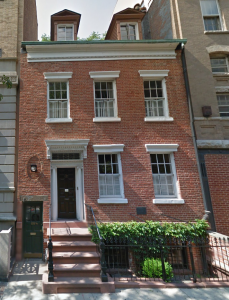More is More: Greenwich Village Historic District Extension

In this series, ‘More is More,’ we look at extensions of historic districts in our area.
In the previous post, we covered the designation of the St. Mark’s Historic District Extension. Today we are going to look at the Greenwich Village Historic District Extension, designated in 2006. This was the first-ever expansion of the Greenwich Village Historic District, and only the second new historic district in Greenwich Village since 1969.
As early as 1963, Jane Jacobs wrote to the chair of the New York City Landmarks Commission that the Far West Village should be included in any planned Greenwich Village Historic District, and the boundary then under consideration should be extended to West Street. This was not to be.
Fast forward to 2004, and GVSHP submitted a request for the landmark designation of the Far West Village and Greenwich Village waterfront. This report was the result of considerable documentation and research of the history and architecture in this area and it cited the area’s diversity of residential, maritime-related and industrial architecture along the Hudson River representing the area’s almost 200 year history. The report went on to state: “A considerable amount of recent construction has taken place in the area, and some of the Far West Village’s historic buildings have been lost or unsympathetically altered due to a lack of landmark protections. More historic resources are threatened. The Greenwich Village Society for Historic Preservation submits the following proposal to protect, honor, and maintain these valuable historic resources before they are further compromised or lost altogether.”
As a result, in October and December of 2005, the LPC held a hearing on a proposed Greenwich Village Historic District Extension (which, along with the Weehawken Street Historic District and the designation of several individual landmarks, was the outcome of GVSHP’s push for expanded landmark protections in this area). Along with GVSHP, a number of elected officials, preservation groups, owners, block associations and Community Board 2 spoke in favor of the designation, and on May 2, 2006, the district was designated along with the Weehawken Street Historic District.
Comprised of 45 buildings, it is, according to the designation report, “a distinctive part of the history and character of Greenwich Village and its far western Hudson River waterfront section.” Several buildings stand out as representative of the several phases of construction in the area; in looking at them, it’s hard to believe they were not included in the original Greenwich Village Historic District designated in 1969.


The first era of development was from c. 1819- c. 1853 when New Yorkers, in an effort to escape the overcrowding and epidemics of lower Manhattan, moved to the Greenwich Village area and made it their home. Some row houses from that era remain intact including 132 Charles Street, a vernacular row house built c. 1819 and 131 Charles Street, a Federal row house built in 1834 and featured in our newly updated Federals Report.


Construction of the Hudson River Railroad along West Street during the mid-19th century helped to spur commercial activity around this thoroughfare. Following the Civil War, the demographics changed in this area as middle class residents moved uptown and less well-to-do immigrants moved in. Existing row houses were tenementized to accommodate multiple families and new tenement and apartment buildings were constructed. New institutional buildings were constructed as well during this phase to meet the needs of the growing population. Examples include Public School No. 7 (1885-86), St. Veronica’s Roman Catholic Church (1890) and the former 9th Police Precinct Station House (1896-97).



Before the end of the 19th century, the Hudson River surpassed the East River as the primary artery for maritime commerce, and West Street north of Christopher Street became the busiest section of of New York’s commercial waterfront. Commercial structures which supported this activity sprung up in and around the district including storage warehouses and transportation-related building types. Two examples include the Romanesque-Revival style warehouse at 277-283 West 10th Street (1894-96) and a stable at 140-144 Perry Street constructed for the nationally significant Fleischmann Company.


This was followed by a period of decline, as Manhattan’s Hudson River waterfront lost its status as center of maritime commercial activity to New Jersey and places farther afield. Subsequently the Far West Village, like Greenwich Village, started to attract individuals associated with the arts, and industrial, commercial, and institutional buildings were converted to residential use during the last third of the 20th century. Many of these buildings continue their residential use today.
For further information on the Greenwich Village Historic District Extension, please see the designation report, click HERE and for the latest new on GVSHP’s advocacy efforts in the Far West Village, please click HERE.

One response to “More is More: Greenwich Village Historic District Extension”